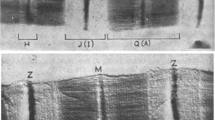Summary
Cardiac muscle M-band structures in several mammals (guinea pig, rabbit, rat and cow) and also from three teleosts (plaice, carp and roach), have been studied using electron microscopy and image processing. Axial structure seen in negatively stained isolated myofibrils or negatively stained cryo-sections shows the presence of five strong M-bridge lines (M6, M4, M1, M4′ and M6′) except in the case of the teleost M-bands in which the central M-line (M1) is absent, giving a four-line M-band. The M4 (M4′) lines are consistently strong in all muscles, supporting the suggestion that bridges at this position are important for the structural integrity of the A-band myosin filament lattice. Across the vertebrate kingdom, cardiac M-band ultrastructure appears to correlate roughly with heartbeat frequency, just as in skeletal muscles it correlates with contraction speed, reinforcing the suggestion that some M-band components may have a significant physiological role. Apart from rat heart, which is relatively fast and has a conventional five-line M-band with M1 and M4 approximately equal, the rabbit, guinea pig and beef heart M-bands form a new 1+4 class; M1 is relatively very much stronger than M4.
Transverse sections of the teleost (roach) cardiac A-band show a simple lattice arrangement of myosin filaments, just as teleost skeletal muscles. Almost all other vertebrate striated muscles, including mammalian heart muscles, have a statistical superlattice structure. The high degree of filament lattice order in teleost cardiac muscles indicates their potential usefulness for ultrastructural studies.
It is shown that, in four-line M-bands in which the central (M1) M-bridges are missing, interactions at M4 (M4′) are sufficient to define the different myosin filament orientations in simple lattice and superlattice A-bands. However the presence of M1 bridges may improve the axial order of the A-band.
Similar content being viewed by others
References
BENNETT, P., STARR, R., ELLIOTT, A. & OFFER, G. (1985) The structure of C-protein and X-protein molecules and a polymer of X-protein. J. Mol. Biol. 184, 297–309.
CARLSSON, E., GROVE, B. K., WALLIMANN, T., EPPENBERGER, H. M. & THORNELL, L. E. (1990) Myofibrillar M-band proteins in rat skeletal muscles during development. Histochemistry 95, 27–35.
CRAIG, R. & OFFER, G. (1976) The location of C-protein in rabbit skeletal muscle. Proc. Roy. Soc. Lond. B192, 451–61.
EDMAN, A-C., SQUIRE, J. M. & SJOSTROM, M. (1988a) Fine structure of the A-band in cryo-sections: diversity of M-band structure in chicken breast muscle. J. Ultrastruct. Mol. Struct. Res. 100, 1–12.
EDMAN, A.-C., LEXELL, J., SJOSTROM, M. & SQUIRE, J. M. (1988b) Structural diversity in muscle fibres of chicken breast. Cell Tiss. Res. 251, 281–9.
HARFORD, J. J. & SQUIRE, J. M. (1986) ‘Crystalline’ myosin cross-bridge array in relaxed fish muscle: low angle diffraction from plaice fin muscle and its interpretation. Biophys. J. 50, 145–55.
HARFORD, J. J. & SQUIRE, J. M. (1992) Evidence for structurally different attached states of myosin cross-bridges on actin during contraction of fish muscle. Biophys. J. 63, 387–459.
KNAPPEIS, G. G. & CARLSEN, F. (1968) The ultrastructure of the M-line in skeletal muscle. J. Cell Biol. 38, 202–11.
LUTHER, P. K. & CROWTHER, R. A. (1984) Three dimensional reconstruction from tilted sections of fish muscle M-band. Nature 307, 566–8.
LUTHER, P. K. & SQUIRE, J. M. (1980) Three-dimensional structure of the vertebrate muscle A band. II. The myosin filament superlattice. J. Mol. Biol. 141, 409–39.
LUTHER, P. K., MUNRO, P. M. G. & SQUIRE, J. M. (1981) Three-dimensional structure of vertebrate muscle A-band. III. M-region structure and myosin filament symmetry. J. Mol. Biol. 151, 703–30.
MATSUBARA, I. (1980) X-ray diffraction studies of the heart. Ann. Rev. Biophys. Bioeng. 9, 81–105.
SJOSTROM, M. & SQUIRE, J. M. (1977a) Fine structure of the A-band in cryo-sections: the structure of the A-band of human skeletal muscle fibres from ultra-thin cryo-sections, negatively-stained. J. Mol. Biol. 109, 49–68.
SJOSTROM, M. & SQUIRE, J. M. (1977b) Cryo-ultramicrotomy and myofibrillar fine structure: a review. J. Microsc. 111, 239–78.
SQUIRE, J. M. (1973) General model of myosin filament structure. III. Molecular packing arrangements in myosin filaments. J. Mol. Biol. 77, 291–323.
SQUIRE, J. M. (1981) Structural Basis of Muscular Contraction. New York: Plenum Press.
SQUIRE, J. M. (1986) Muscle: Design, Diversity & Disease. Menlo Park, CA: Benjamin/Cummings.
SQUIRE, J. M., LUTHER, P. K. & AGNEW, G. D. (1986) Averaging of periodic images using a microcomputer. J. Microsc. 142, 289–300.
STREHLER, E. E., CARLSSON, E., EPPENBERGER, H. M. & THORNELL, L. E. (1983) Ultrastructural localization of M-band proteins in chicken breast muscle as revealed by combined immunocytochemistry and ultramicrotomy. J. Mol. Biol. 166, 141–58.
THORNELL, L. E. & CARLSSON, E. (1984) Differentiation of myofibrils and the M-band structure in developing cardiac tissues and skeletal muscle. In: Developmental Processes in Normal and Diseased Muscle. Vol. 9. Experimental Biology and Medicine (edited by EPPENBERGER, H. M. & PERRIARD, J. C.) pp. 141–7. New York: Karber Basel.
THORNELL, L-E., CARLSSON, E., KUGELBERG, E. & GROVE, B. K. (1987) Myofibrillar M-band structure and composition of physiologically defined rat motor units. Am. J. Physiol. 253, 456–68.
TURNER, D. C., WALLIMANN, T. & EPPENBERGER, H. M. (1973) A protein that binds specifically to the M-line of skeletal muscle is identified as the muscle form of creatine kinase. Proc. Nat. Acad. Sci. USA 70, 702–5.
VINKEMEIER, U., OBERMANN, W., WEBER, K. & FURST, D. O. (1993) The globular head domain of titin extends into the centre of the sarcomeric M-band. J. Cell Sci. 106, 319–30.
WALLIMAN, T. & EPPENBERGER, H. M. (1985) Localization and function of M-line bound creatine kinase. Cell Muscle Motil. 6, 239–85.
WALLIMAN, T., DOETSCHMAN, T. C. & EPPENBERGER, H. M. (1983) Novel staining pattern of skeletal muscle M-lines upon incubation with antibodies against MM-creatine kinase. J. Cell Biol. 96, 1772–9.
Author information
Authors and Affiliations
Rights and permissions
About this article
Cite this article
Pask, H.T., Jones, K.L., Luther, P.K. et al. M-band structure, M-bridge interactions and contraction speed in vertebrate cardiac muscles. J Muscle Res Cell Motil 15, 633–645 (1994). https://doi.org/10.1007/BF00121071
Received:
Revised:
Accepted:
Issue Date:
DOI: https://doi.org/10.1007/BF00121071




